Zhang Xin Adv, Academician of Nancewen, Tsinghua University, Wuhan University of Technology Sci.: High performance pressure sensor based on 3D MXene flexible network
With the increasing popularity of intelligent wearable devices, flexible high-performance pressure sensors are urgently needed in various complex application scenarios. The existing flexible pressure sensors face a huge challenge, that is, they need to maintain high sensitivity in a wide temperature range, which is critical for their applications in harsh environments.
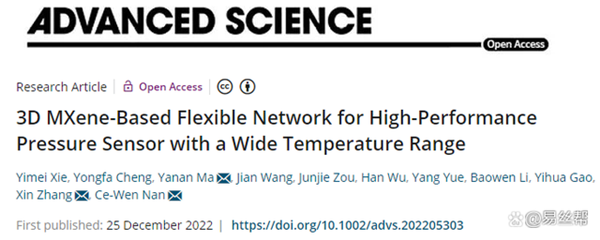
Based on the above challenges, Academician Nan Zewen of Tsinghua University, researcher Zhang Xin of Wuhan University of Technology and others cooperated to report a high-performance flexible piezoresistive sensor based on three-dimensional MXene/PEI network, which is applicable to a wide temperature range (from liquid nitrogen temperature to 150 ° C). The relevant research results were published in the journal Advanced Science with the title of "3D MXene-Based Flexible Network for High-Performance Pressure Sensor with a Wide Temperature Range".
PEI is an amorphous thermoplastic polymer with high temperature resistance, excellent tensile strength and excellent dimensional stability. It has shown great application potential in the aerospace field. In addition, PEI containing ether bonds shows great flexibility and processability, and can construct different micro and macro structures through various physical processes. On the other hand, the emerging MXenes nano-sheet has metal conductivity, excellent mechanical strength and good hydrophilicity, and can withstand certain low temperature (below - 200 ℃) and high temperature (above 400 ℃). It is suitable for building wearable pressure sensor using PEI fiber network under adverse conditions.
Through the layer-by-layer electrospinning process of PEI, a three-dimensional MXene/PEI network was prepared to improve the sensing performance in a wide temperature range. MXene/PEI interconnected 3D fiber network similar to spider web was prepared, and MXene nanoflakes were coated on the surface of each PEI nanowire. This three-dimensional MXene/PEI network benefits from the large deformation under the action of external forces, and improves the sensing performance of piezoresistive sensors at high temperatures. In addition, an ultra-thin PEI layer is assembled between the MXene/PEI network and the flexible electrode as a spacer layer, which can further enhance the conductive path under external deformation. The flexible piezoresistive sensor has excellent sensitivity, short response/recovery time, low detection limit and good durability under high temperature in a wide temperature range (from liquid nitrogen to 150 ° C), and has potential application value in human activities, health monitoring, pressure distribution array and human-computer interaction.
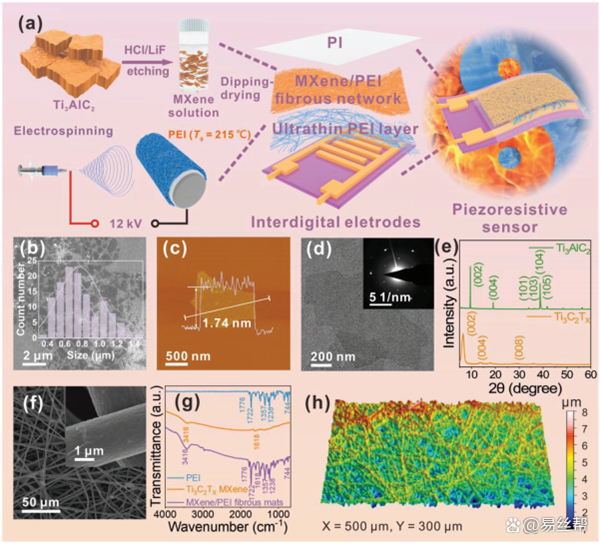
Figure 1 a) Schematic diagram of MPP piezoresistive sensor preparation process. b) SEM image and size distribution of Ti3C2TX MXene nanoflakes. c) AFM image of MXene nano chip. The height distribution shows that the thickness of the nano sheet is ≈ 1.74 nm. d) TEM image of MXene nano-slice. The corresponding selected area electron diffraction pattern is shown in the illustration. e) XRD diagrams of Ti3AlC2 MAX and Ti3C2TX MXene nanosheets. f) SEM images of MXene/PEI fiber network g) Fourier transform infrared (FTIR) spectra of PEI fiber network, Ti3C2TX MXene and MXene/PEI fiber network. h) 3D structure diagram of MXene/PEI fiber network.
In this work, researchers prepared a high sensitivity piezoresistive sensor based on three-dimensional MXene/polyetherimide network. The sensor has ultra-high sensitivity in a wide temperature range (80 kPa − 1 at − 5 ℃, 156 kPa − 1 at room temperature, and 20 kPa − 1 at 150 ℃), a low detection limit of 9 Pa, a fast response time of 163 ms, and long-term durability. It has more than 10000 cycles at room temperature, 2000 cycles at 100 ° C, and 500 cycles at − 5 ° C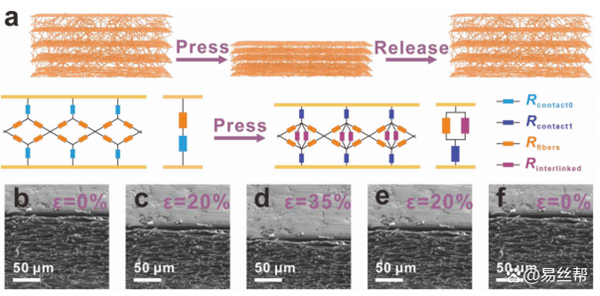
Figure 2 The sensing mechanism of MPP piezoresistive sensor. a) MPP sensor pressure sensing model. B-f) In situ SEM images of MXene/PEI fiber network under different compression conditions.
The pressure sensor can track different human activities in real time, detect the pressure distribution, and be used for human-computer interaction. It can also react sensitively to external mechanical stimuli at high temperature (150 ° C) and low temperature (liquid nitrogen). In addition, the fiber network has good Joule heating capacity, which can reach 78 ° C at 12 V voltage. Therefore, flexible MXene/PEI fiber network has broad application prospects in the field of flexible wearable electronic devices and personal heating systems under harsh conditions.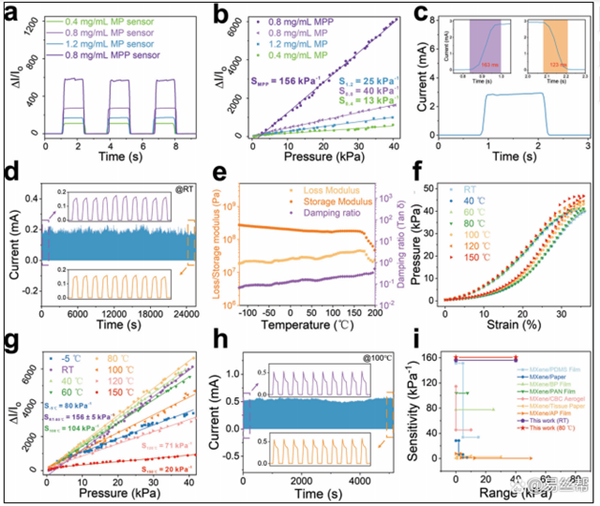
Figure 3 Sensing performance of MPP piezoresistive sensor. a) Current response Δ The relationship between I/Io and time. b) For MXene/PEI sensors with different MXene concentrations, the relative change of current with the change of pressure load( Δ I/Io)。 c) The response time (163 ms) and recovery time (123 ms) of the MPP sensor at a compression speed of 200 mm s − 1. d) The durability test of the sensor under 10 000 continuous loading-unloading cycles. e) Dynamic rheological behavior of MXene/PEI fiber network at - 120 to 200 ° C. f) Stress-strain curve of MXene/PEI fiber network and g) sensitivity of MPP sensor under different temperature conditions from room temperature to 150 ° C. h) The MPP sensor has a cyclic piezoresistive sensing performance of 2000 cycles at 100 ° C. i) Comparison of sensitivity and sensing range of different piezoresistive sensors.
Application of MPP sensor
MXene/PEI piezoresistive sensor has the advantages of high sensitivity and fast response, and is suitable for real-time monitoring of subtle pressure and different human activities. The detection limit of piezoresistive sensor is one of its most critical performance indicators. As shown in Figure 4a, the sensor can detect the small pressure of soybean (9 Pa) and 1 gram (44 Pa). In addition, flexible sensors can be conformally attached to human muscles. As shown in Figure 4b, the minimum muscle movement of the cheek bulge can be recorded. In Figure 4c, the sensor is directly fixed on the wrist skin of an adult male to monitor the pulse in real time, and can clearly distinguish the waveform, which has great application prospects in biomedical monitoring and real-time clinical diagnosis.
Because of its flexibility, the MPP piezoresistive sensor can also be tightly attached to human joints. As shown in Figure 4d, the sensor can detect the bending and straightening movement of the index finger in real time. The sensor also shows high sensitivity to monitor the flexion and extension cycle of human joints, such as wrists, elbows, ankles and knees. In Figure 4f, the sensor also shows a fast response to high-frequency finger tapping. At the ultra-low temperature near the liquid nitrogen temperature, the current signal responds well to the change of cup weight. The wide operating temperature range shows the potential application of the sensor in the aerospace field.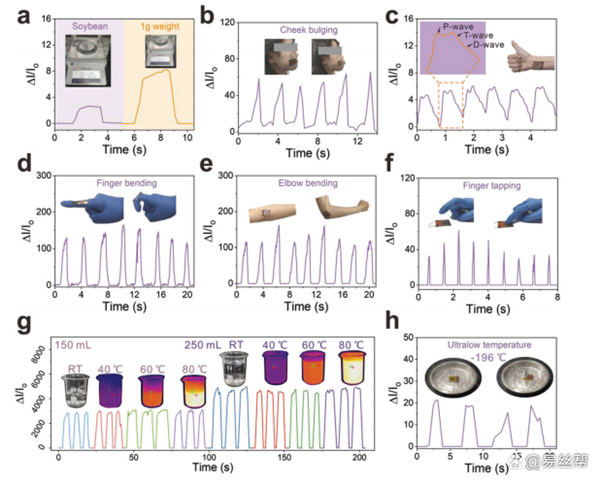
Figure 4 Application of MPP piezoresistive sensor. a) Response curve of pressure of small objects provided by soybean (9 Pa) and 1 g weight (44 Pa), b) cheek bulge, c) wrist pulse (the enlarged image is a single pulse signal containing the characteristic peak called P - wave, T wave and D wave), d) finger bending, e) elbow swinging, f) finger tapping, and g) maintaining the water cup at different temperatures from RT to 80 ° C. h) The sensing performance of MPP piezoresistive sensor at ultra-low temperature (liquid nitrogen).
The Internet of Things (LoT) is the core of the information age and is composed of a variety of sensors. In order to further study its application in the LoT field, the MPP piezoresistive sensor is connected to the Bluetooth system. As shown in Figure 5a, the system can convert the perceived pressure signal into radio electromagnetic wave signal. Then the change of current can be monitored and recorded on the mobile phone. As shown in Figure 5b, the sensor array can quantify the pressure distribution by monitoring the current intensity of each pixel point to determine the specific position of the chessmen. In addition, the highly flexible sensor is installed on the leg of the robot, as shown in Figure 5c. When the robot swings its arm to walk, the sensor generates a response signal.
Figure 5 a) The MPP piezoresistive sensor is connected to a circuit containing a Bluetooth module, which wirelessly transmits the signal of finger tapping to the mobile phone. b) Place the chess pieces at 4 × 4 MPP piezoresistive sensor pixel array to detect the corresponding pressure distribution. c) MPP piezoresistive sensor monitors robot motion in real time. d) When different pressure is applied to the MPP piezoresistive sensor, the brightness response of the LED changes. e) Schematic diagram of MXene/PEI fiber network attached to the skin surface for joule heating. f) Temperature distribution of MXene/PEI fiber network with concentration of 0.8 mg mL − 1 under different operating voltages. g) Infrared thermal image of MXene/PEI fiber network with a concentration of 0.8 mg mL − 1 when the voltage gradually increases from 0 to 12 V.

